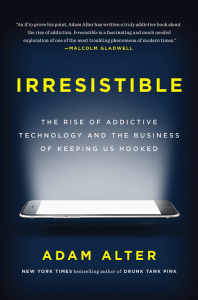"When training is not just about the physical act but also about your goals and your point of focus and what you’re doing with your mind, I think a happy by-product of that is less anxiety and fewer dark issues of the soul, because it’s a proactive way of training."—Vanessa Cornett, in our interview about new book The Mindful Musician.
Irresistible Technology: An Interview with Adam Alter
 Adam Alter’s latest book is “Irresistible: The Rise of Addictive Technology and the Business of Keeping Us Hooked.” In it, he describes the problem of rampant behavioral addiction and the calculated techniques of games, apps and other tech products to get and hold our attention… even to the point of our own detriment. He speaks with me in this interview about behavioral addiction, mindfulness and the importance of appreciating technology while not being ruled by it. He’ll be speaking at John Adams Institute in Amsterdam on April 20, 2017.
Adam Alter’s latest book is “Irresistible: The Rise of Addictive Technology and the Business of Keeping Us Hooked.” In it, he describes the problem of rampant behavioral addiction and the calculated techniques of games, apps and other tech products to get and hold our attention… even to the point of our own detriment. He speaks with me in this interview about behavioral addiction, mindfulness and the importance of appreciating technology while not being ruled by it. He’ll be speaking at John Adams Institute in Amsterdam on April 20, 2017.
When it comes to our addiction to technology that we’re currently witnessing, tell us: What’s the big deal? What are the stakes?
The stakes are especially high with regard to children. We know that when children interact with screens rather than people, they don’t get to experience the trial-and-error process that allows them to learn how to navigate the social world. People basically try lots of tactics and approaches when they’re young, and they learn what works and what doesn’t. They learn that if you steal another child’s toy, or if you make fun of another child, that the response is not positive and it’s not a pleasant interaction, so they get socialized over time. And if children spend enough time in front of screens instead of in front of real people, they aren’t socialized in the same way, and it breeds a certain kind of nastiness in them. Basically, screens remove us from the presence of other people, so it’s easier to be mean.
So, one of the big stakes is that we’re raising this generation of children in the screen era, who are now only 7-10 years old, who have only known a world with the iPhone and iPad, and who may end up being in some way materially different from earlier generations and perhaps less socially capable.
Tell us what it means to be addicted to technology.
When I talk about technology addiction broadly, the definition of behavioral addiction is something that you do compulsively that feels good in the short-term, but in the long-term compromises your well-being in some respect, whether that’s social, physical, psychological or even financial.
It’s true that engaging with video games and smart phones and seeing likes on your Instagram posts raises your dopamine levels, but that’s not enough. The real key here is you need to understand what’s going on when you engage in these behaviors, and when they become a crutch. When they become a way of scratching some psychological itch that you have – whether it’s loneliness, or anxiety or depression, or low self-esteem or boredom – if you are turning to some device or some experience to scratch that itch to help you deal with that deficit, then there’s a good chance you’re addicted.
What are some of those long-term consequences?
That can be social in the way that it disrupts adults from spending good quality time with their loved ones and friends; It could be financial as there are a lot of people who play games and they find that they spend thousands and thousands of dollars on in-game purchases, which is not a small minority, it’s a lot of people actually; or it can be physical, in the way that there are a lot of people don’t get exercise and end up sitting on the couch for long periods of time, or even there’s a lot of evidence that people have bad road accidents, because for example they walk into traffic when they’re so engaged with their phones that they refuse to stop texting or communicating with people; And then there are the psychological consequences of engaging with phones rather than with people face-to-face. I already mentioned the fact that people tend to be nastier and a little bit more cutting when they communicate online, because a lot of the social awareness that keeps us friendly and open is removed, and that makes us a little less pleasant to be around.
Is it all possible that these changes are something that’s inevitable or even desired for the future world, as we interact more with machines than people?
The aim of the book is to suggest not that we dial back technology and go back to the 1950s, but just that we are more mindful about how we use technology. In this modern world, we will be exposed to new technologies, and we need to be fluent with those – we need to understand how they work, we need to be comfortable with them – we just need to learn how to dial back our usage to some extent so that we preserve some of what makes the offline world so rewarding and rich.
And, children eventually will need to understand how to use a tablet, it just so happens that tablets are so well designed that most kids learn that when they’re one year old and they learn it in ten seconds. We don’t need to expose them to screens constantly.
Do you have any tips on how we can apply mindfulness to our use of technology?
It’s a really good question, and I think it’s a complicated question. The first thing you need to do is be informed about how much tech you’re using. Most people have no idea. There’s an app called Moment, that measures how long you spend with your phone and how many times you pick up your phone every day. What’s really interesting for me about this app is that when you ask people before they use it to estimate how much time they spend with their phone, on average they say half the actual amount. When I first used it, I thought I used my phone about an hour a day – in fact, I use my phone three hours a day, which is average in the United States. That to me is the first step. You can’t be mindful if you don’t even realize how much time you’re spending on devices.
One thing I do that is very useful is set boundaries and plan ahead of time when I will not use my phone. It’s very hard to resist temptation, so those boundaries can help me avoid the temptation altogether. For example, I say I will not use my phone between 5 and 7 PM, which is usually the time I spend after work with my son. I put my phone and my tablet in a closed drawer in another room. This is time to spend face to face, or exercising, or if it’s a nice day I’ll spend the time outside, but I will not use my phone for those two hours.
A big part of being mindful is about having strategies that allow you to ensure that for at least a few hours of the day you engage with the real world – the offline world – rather than diving into this very easy, very simple online world that gives you everything you need and demands very little of you.
Considering how integrated computers and phones are into our working lives, what distinguishes a behavior as part of ‘doing our job’ from one of addiction?
Part of the commentary that I’m making is cultural. If your job requires you to have a phone with you 24-hours a day, I’d say the culture is broken and needs fixing. Part of the conversation we need to have involves asking: Why are people taking their phones with them such that 70% of the population can reach their phones without moving their feet 100% of the time. That’s 7 out of 10 people that you can ask them in the middle of the night, at 3am, “Can you reach your phone without moving your feet?” – who will say yes. That says to me that something is broken, the culture needs fixing. You shouldn’t be at work 24 hours a day and you shouldn’t be accessible by work 24 hours a day.
Part of this is about consumers and suggesting that we as individuals who use technology should change the way we behave, but a big part of it is about producers of technology and also the people who push us to use technology. So, workplaces that require us to be accessible 24 hours a day are a huge part of the problem. They need to reform the way they demand that sort of accessibility, that sort of portal to us, at all times. It’s bad for work productivity, and it’s also bad for workers.
If the root of this impulse is connectivity to others, is that an example of good intention gone bad?
Absolutely. I would argue that this isn’t really about connectivity in the sense that we think of as a positive. The kind of connectivity we’re talking about here is not the same useful, rich and enriching kind of connectivity as in face to face interactions, or physical touch or looking into someone’s eyes. The form of connection you have through technology, even if you’re on Facetime or Skype or any other video platform, is a diminished form of connection. It doesn’t convey the same sentiments, you don’t get the same rapid feedback, and it’s not as rich as the kind of connections you get face to face.
Now, if like me you have family halfway across the world, these screen connections are certainly better than nothing. But I wouldn’t say that I therefore need to make myself available 24 hours a day. I think we need to agree that there are times when you should be on screens, and times when you shouldn’t. Anyone who says they want to be reachable by everyone else in their lives 24 hours a day, I think is misguided.
But certainly, as I always go back to, there are major benefits to having technology and screens, and being able to connect to people who are remote. It just has its place.
This interview was originally published on the John Adams Institute site.



